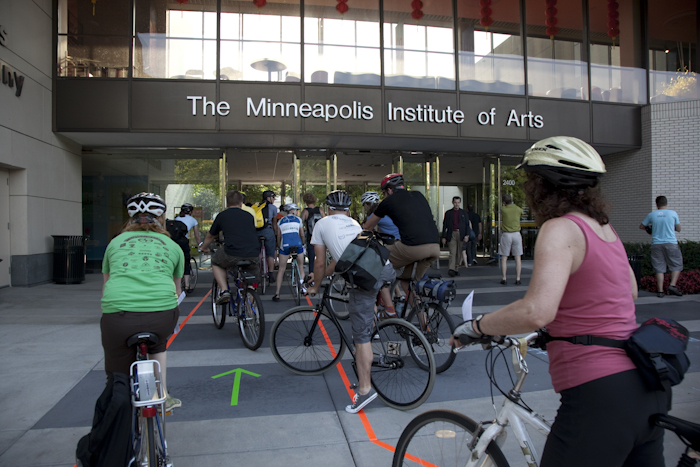A good society needs places where our common humanity comes first and where trust can take root and grow. Museums should be among these places.
Over the years, in our work with museum exhibitions, my friend Kathy McLean and I had observed that how we organize physical space and how we inhabit it has a lot to do with whether or not museums realize this potential. We explored these ideas in a book called The Convivial Museum. We used the word convivial with an eye to the work of Ivan Illich (author of Tools for Conviviality) and to its etymology: the word convivial comes from the Latin com (together) + vivere (to live).
Most people who work in and with museums would recognize the qualities of a convivial museum—what we described as “a welcoming spirit, orientation to the community, comfort, places for engagement, places for rest, a spark of life.”
We wondered whether we might find evidence of these qualities—or their absence—in photographs taken by museum visitors. So we looked at thousands of them as we put the book together, on Flickr and other sites. What we found were the expected snapshots, like groups posing in front of a statue. But there were others—smiling cyclists rolling their bikes into the front doors of an art museum, a couple deeply engaged in conversation, an exhausted visitor slumped on a chair—that gave gave us a more nuanced view of how people experience museums. A number of these images are included in the book, thanks to the generosity of the people who took them. (This photo is by Lacey Criswell.) As we looked at these photographs and thought about what they told us about museum design, we noticed some of the qualities identified in a book called A Pattern Language by architect Christopher Alexander. In a similar spirit, Alexander seeks in that book to identify qualities of built environments that make us feel more alive. We also learned from the work of planners of public spaces like parks and markets who have long known that movable seating, buskers, and fountains can reliably animate a space.
As we looked at these photographs and thought about what they told us about museum design, we noticed some of the qualities identified in a book called A Pattern Language by architect Christopher Alexander. In a similar spirit, Alexander seeks in that book to identify qualities of built environments that make us feel more alive. We also learned from the work of planners of public spaces like parks and markets who have long known that movable seating, buskers, and fountains can reliably animate a space.
A legible and easy approach, an entry experience that lifts the spirits and conveys a sense of warmth and welcome, settings that encourage people to talk and work together, corners for quiet reflection, attention to comfort, ample seating: these are among the features of a convivial museum, we found.
Museum missions have long since ceased to focus on collections, research, and interpretation. But that doesn’t always mean that they have fully embraced this other role, as convivial public places. The obstacles are many and very real. Some are saddled with buildings that have huge operating costs, even debt from outsized building projects, or upper management who want faster “through-put” and consider floor staff expendable. And very few museums remain as open and accessible—as truly public—as public libraries.
But don’t give up, we want to say. Try to slow down, listen, talk things over, try things out, reflect. If you’re a museum director, that means you, too, Kathy wrote. “Practicing conviviality . . . requires that we step outside of our overwhelmed selves to be gracious and fully present, taking time to welcome a person who may seem lost or confused, to listen to a child’s questions, to articulate the intent of an exhibition, to suggest a way to explore more deeply—or simply to bend down and pick up a crumpled brochure . . . . In times like these, fostering human relationships and strengthening a sense of communal purpose may be the most important contributions museums can make.” Although we published this book in 2010, the advice may be even more relevant today.
We are grateful to the US Institute of Museum and Library Services for supporting the publication of this book. and to Paul Orselli for his lengthy review in the journal of the National Association for Museum Exhibition. The book is available from the Association of Science-Technology Centers.